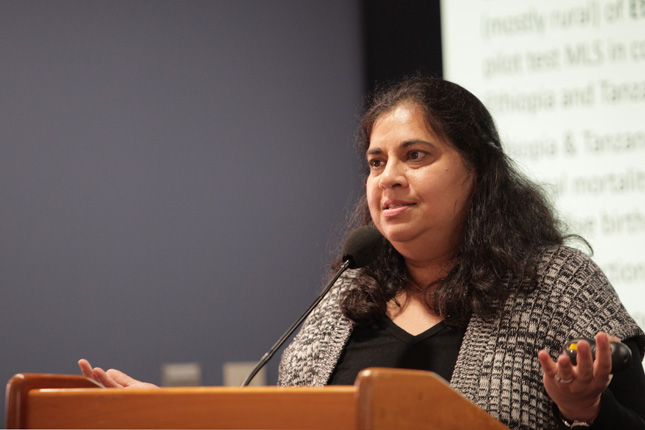-
Innovations in Midwifery Save Mothers’ Lives: Q&A With Geeta Lal
November 9, 2017 By Yuval Cohen
To prevent maternal mortality, we need new approaches to this very old problem. The United Nations Population Fund (UNFPA)’s Midwifery Programme, which operates in 120 countries, recently launched an innovative tool to improve training for maternal health workers. Dot-Mom, the column of the Maternal Health Initiative on New Security Beat, recently spoke with Geeta Lal, global coordinator for the Midwifery Programme, about the challenges of developing innovations in maternal health and new projects on the horizon for UNFPA.
Dot-Mom (DM): What inspired your commitment to maternal health?
Geeta Lal (GL): My work for UNFPA in developing countries exposed me to the needless suffering that families undergo due to the untimely death of women during pregnancy and childbirth, and inspired me to become a strong advocate for maternal health issues. What was painful for me was that a majority of these pregnancy-related deaths and disabilities were entirely preventable. It is most often a reflection of poor and failed health systems, and gender dynamics. At times, it is simply the lack of sexual and reproductive health (SRH) information and universal access to quality SRH services that leads to untold deaths and disabilities in women and their newborns.
DM: What is the most promising project you are currently working on with the Midwifery Programme?
GL: Access to quality midwifery services for all pregnant women and a functional health system are key to maternal health. I have recently worked on revising and updating UNFPA’s Global Midwifery Strategy with our core midwifery team to address midwifery holistically. In addition to quality midwifery education, strong regulatory frameworks, and strong associations, the Midwifery Strategy also looks at midwifery workforce policies to promote adequate retention and distribution of midwives. The goal is to foster an enabling environment for midwives and strong advocacy to place quality midwifery care at the center of sexual, reproductive, and maternal health services.
DM: What is the most pressing challenge for the global community to overcome in order to improve maternal health and how do we address it?
GL: The global community must address the three most critical areas of maternal health, namely: access to quality midwifery services; availability and access to emergency obstetric care for which functional health facilities are required; and family planning. Health-seeking behaviors among pregnant women at the community level also need to be promoted, combined with access to quality and timely maternal health services.
DM: At a recent Wilson Center event, you gave a demonstration of the UNFPA’s new training tool, the Portable Mobile Learning System (MLS), a portable projector equipped with pre-loaded training modules for health workers. What makes the MLS innovative?
GL: It is the simplicity, user-friendliness, cost effectiveness, and portability of the MLS that has made it such a success. The MLS is most suitable for low-resource settings with poor infrastructure, lack of internet, and frequent electricity outages. The light, portable hand-held projector that is part of the MLS has a built-in Android tablet and comes pre-packaged with world-class midwifery training materials on key obstetric emergencies that are major killers of women during pregnancy and childbirth (e.g., post-partum hemorrhage, pre-eclampsia/eclampsia, obstructed labor, post-abortion care, etc.). The projector also has SIM card, flash drive, and Micro SD ports that allow for additional training materials to be added. We also include a solar panel and a powerful battery with the MLS, so in the case of electrical outage, the extra battery (charged by solar power) can provide an additional 8 hours of life. Any white wall in a rural setting can be used with the small battery-operated projector; no elaborate classroom setting is needed for multi-media training. All these features make the MLS an effective alternative and innovative solution to health workforce training.
DM: What is the most important thing to remember when designing sustainable solutions for maternal health issues?
GL: For a sustainable solution, one needs a women-centered health systems approach. One must put the woman at the center as the intended beneficiary, and accordingly identify and design access to a well-trained and supported health care team (midwife, nurse, doctor, anesthesiologist, clinicians, pharmacist, supporting members of family, etc.); healthcare infrastructure and resources (e.g., health facility, maternity waiting home, equipment, supplies, etc.); and conducive policies and sustainable financing that help provide an enabling service delivery environment. There is no sustainability unless the health system is in place.
Sources: United Nations Population Fund
 A Publication of the Stimson Center.
A Publication of the Stimson Center.



